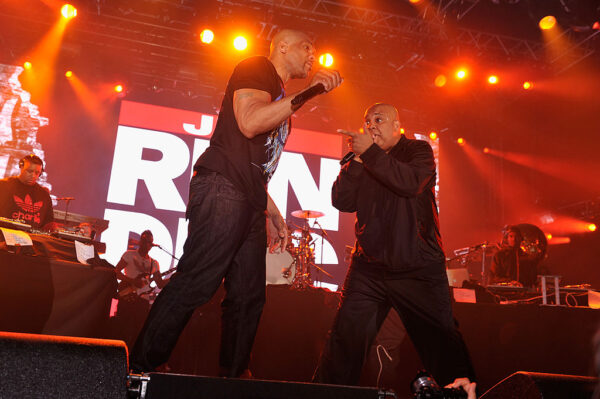The legacy of Run-DMC starts in New York’s Hollis, Queens, neighborhood after music executive Russell Simmons decided to help his younger brother Joey “DJ Run, Son of Kurtis Blow” Simmons start a rap group with two other neighborhood kids, Darryl “DMC” McDaniels and Jason “Jam Master Jay” Mizell. The three made history multiple times, experiencing great financial highs and lows while being at the helm of commercial rap music for almost 40 years.

With the 50th anniversary of hip-hop approaching and the group scheduled to give their farewell concert in April, the Rock & Roll Hall of Famers show no signs of slowing down as entrepreneurs.
Together, the brand Run-DMC is worth a lot of money. However, individually, Simmons has an estimated net worth of $60 million and McDaniels has one of $40 million. Both achieved their wealth through myriad ways, exploring new territories that included television, comic books, toys, and the ministry.
Music Money
For the majority of its career, Run-DMC was signed to Profile Records and not Def Jam, the label Russell Simmons founded with Rick Rubin. The trio produced six studio albums and one official greatest hits project that totaled nearly 6.5 million records sold, according to BestsellingAlbum.com.
Their 1986 album, “Raising Hell” went triple platinum, “Tougher than Leather” and “King of Rock” both went platinum, and “Down with King” and their self-titled 1983 debut album “RUN-DMC” both went gold.
The group’s millions of record sales did not account for all of the money that they made. As a group in the 1980s and 1990s, they relied heavily on touring and endorsement deals to amass their wealth. Making money through their publishing, and licensing their songs for television, commercials, and films also added to their lucrative portfolio.
The group starred in two of the first films centered on hip-hop groups: “Krush Groove” and “Tougher than Leather.” The movies also synced with their albums and provided additional marketing and roll-out for the three artists.
Ways Run Made His Money
Simmons started to release music on his own after the 2002 death of Mizell. In 2005, he released the album “Distortion.” One of the singles, “Mind on the Road,” was featured in the video game “Madden NFL 06,” allowing one of the two voices behind “My Adidas” to license his music to a new breakout form of music placement.
Shortly after this, his family entered reality television with his groundbreaking show “Run’s House” in 2005. The hit show ran for six seasons on MTV and aired almost 60 episodes. The show was based in his $1.6 million Saddle River, New Jersey, home. The six-bedroom mansion served as the show set and a recording studio, providing tax breaks for the rapper.
The family sold the house with its renovations that included a home theater and indoor basketball court for $5.5 million in 2007.
In 2014, he debuted other shows like “Rev Run’s Renovation” on HGTV and the DIY Network and “Rev Run’s Sunday Suppers” on the Cooking Channel.
He then took a show on the Travel Channel called “Rev Runs Around the World” in 2015.
Simmons, who now goes by Rev. Run, is also an author. He wrote several books such as “Words of Wisdom: Daily Affirmations of Faith,” “Take Back Your Family: A Challenge to America’s Parents,” and “Manology: Secrets of Your Man’s Mind Revealed.”
How Did DMC Get His Money?
In his memoir, DMC was very open about his struggles with addiction and alcohol abuse, bad habits that contributed to the breakdown of the group even before the death of Jam Master Jay.
In fact, his abuse often interfered with touring, which is the way most artists make the lion’s share of their money.
Much worse, after JMJ died in 2002, DMC lost his father, discovered he was adopted and had to battle an acute alcohol-induced form of pancreatitis, the Guardian reports.
DMC decided he needed to go rehab and get counseling, saying “Therapy is the most gangsta thing you can do.” He also started to focus on his spiritual self, even deciding for himself “God is a woman.”
“I don’t care what you wanna call god: Yahweh, Buddha, Almighty, Allah, whatever you wanna call her. I think God’s a woman ’cause my wife and mother are so cool,” he said.
This investment in himself changed his life.
Once he was able to become sober, he shifted his life and took advantage of his gifts.
He released the two solo projects, “Checks Thugs and Rock n Roll” in 2006 and “Back from the Dead,” an EP, in 2017.
Like Rev. Run, he lent his signature raspy voice and music to video games like “The Warriors” in 2005 and “Guitar Hero: Aerosmith” in 2008, earning him licensing money, also publishing books, “King of Rock: Respect, Responsibility, and My Life with Run-DMC” in 2001 and aforementioned biographical tale “Ten Ways Not to Commit Suicide: A Memoir” in 2016.
His most passionate effort is his publishing imprint Darryl Makes Comics founded in 2014, where he makes kid-friendly comic books. He debuted his self-titled graphic novel, one co-written with Damion Scott.
He also continues to tour, which brings in revenue.
According to Celebrity Talent International, the starting range to book Run-DMC is $150,000-$299,000.
Jam Master Jay Died With Little Money on the Books
Jam Master Jay, the heart of Run-DMC, added the edge to the group that Simmons and McDaniels did not have. Despite being recognized for being the anchor of the group, when the trio started to die down and his JMJ label, which originally signed 50 Cent, was not profitable, it is alleged he began to teeter with one foot in the streets and one in the music industry.
This is the backdrop for his 2002 slaying inside his Jamaica, Queens, recording studio. He was shot twice in his chest. The man Ralph McDaniels once called one of the “world’s greatest DJs of all times” died at 37.
A trial for two men accused of killing Jam Master Jay is due to start in February, 21 years after his untimely demise, according to Rolling Stone.
Prior to his death, it is alleged by the Department of Justice that Mizell was trafficking drugs, and if this is true none of that money would have been declared as earnings.
On the books, it is estimated he had a net worth of -$1 million. The Internal Revenue Service reported Jay owed about half a million in debt to them.
Reports say $171,000 of that was in federal tax liens and “nearly $300,000 in state taxes dating back to 1989, including $172,000 in personal state tax and $54,339 in corporate taxes” on the same recording studio he was killed in.
Considered one of the top 50 greatest artists of any genre of all time by Rolling Stone magazine, Run-DMC became the first rap act to appear on that magazine’s cover, the first rappers to have music videos air on MTV, and their album “Raising Hell” is the first multi-platinum record in hip-hop.
April will top off this amazing career with a farewell concert at Madison Square Garden.
McDaniels dropped the news in January, leaking, “The final show that we are ever going to do is going to be at Madison Square Garden in April. It’s going to be the last episode of the documentary we’re doing. Run-DMC’s last show ever. ‘Cause it’s time for Run to go be Paul McCartney and me to be John Lennon.”
“We done did what we could do,” he said.
Even this is a money play. They believe the documentary will be dropped on Netflix, but the group is open to other bidders.
“We’re gonna do it with Netflix or to the highest bidder,” McDaniels said. “It’s going to be a live production. Run-DMC’s doing The Last Waltz at Madison Square Garden. Who wants to pay $100 million to own it?”





Can’t wait for concert